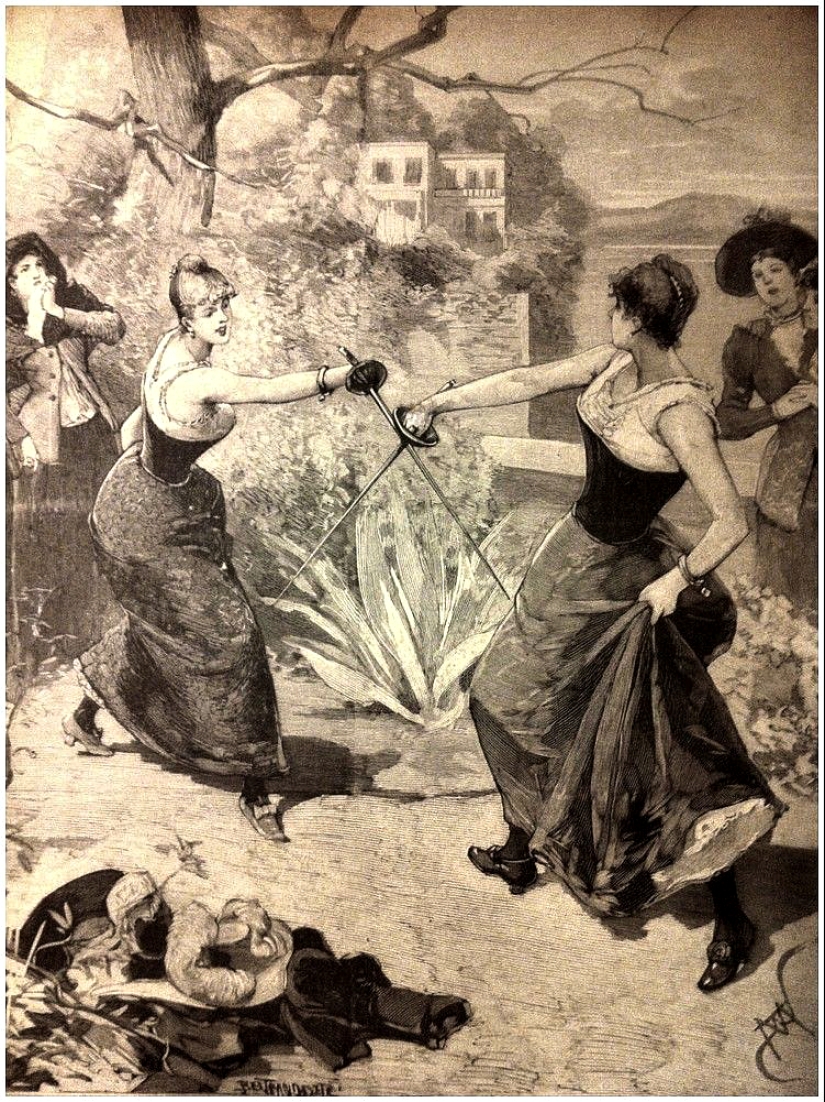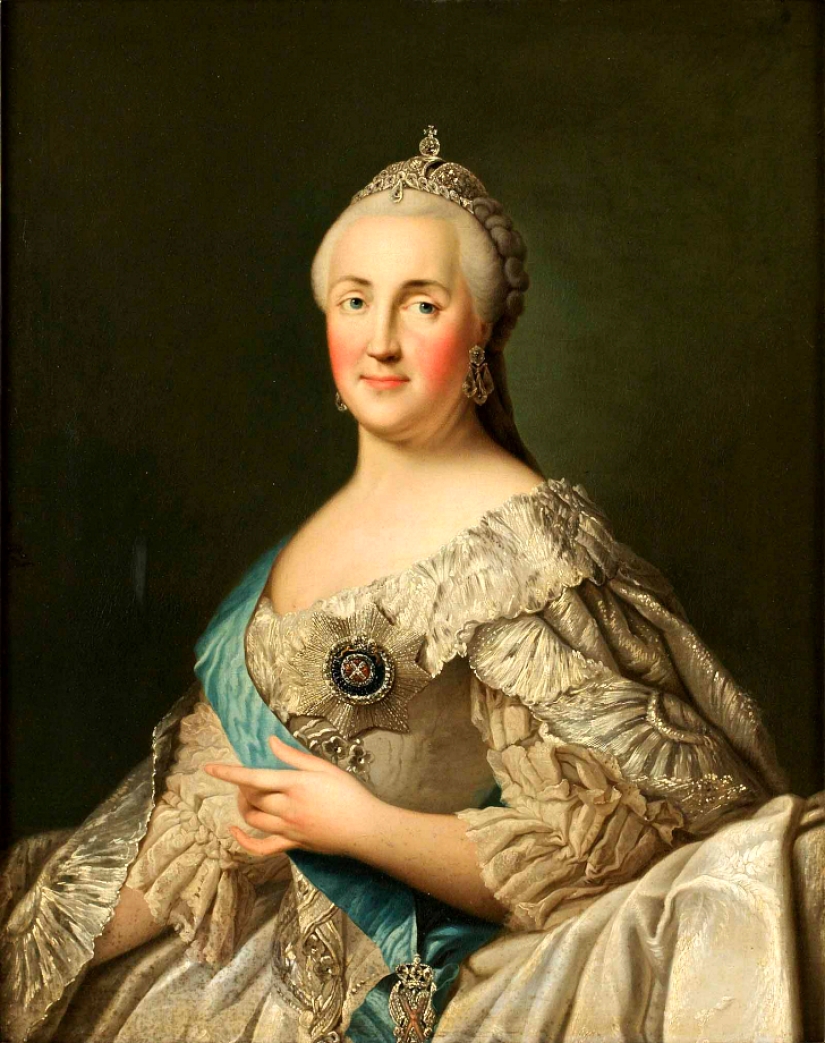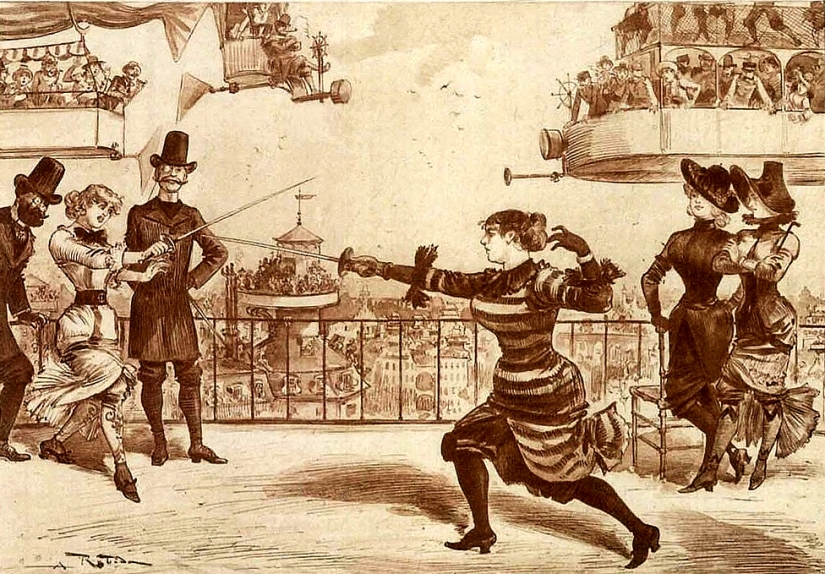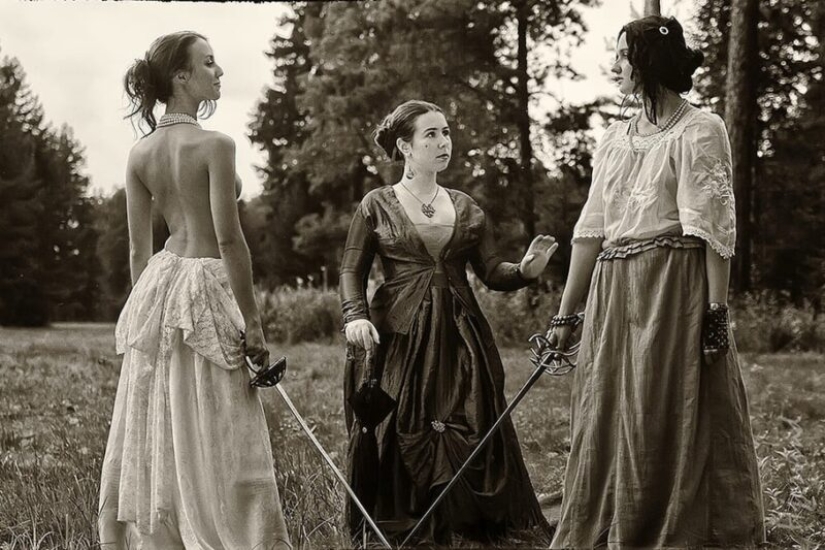History of women's duels
Categories: Conflict | History | World
By Pictolic https://pictolic.com/article/history-of-womens-duels.htmlDueling is considered the prerogative of men, but this opinion is erroneous. Women, too, were not averse to fighting each other, moreover — duels between them were not so rare and for the most part much more bloody and sophisticated.

For some reason, the most legendary female duel is considered to be the duel between the Marquise de Nesle and the Countess de Polignac in the autumn of 1624. Not sharing the favor of the Duke of Richelieu, who later became a cardinal, the ladies, armed with swords and invited seconds, went to the Bois de Boulogne, where they fought.
The duel ended with the victory of the Countess, who wounded her rival in the ear. This duel was not something special, but, thanks to Richelieu, in whose notes this case is mentioned, and the memories of the duelists themselves, it left a mark on history.

The chronicle of women's duels could be traced back to ancient times, when matriarchy reigned and women took a more active life position. But since there are no documentary sources about that period, we can say that we will move further in time.
The first reliable information about women's duels dates back to the XVI century. And they, by the way, dispel the myth that the pioneers in this business were French women.
Thus, in the chronicle of the Convent of St. Nicholas in Milan, Benedicta mentions that on May 27, 1571, two noble senoritas arrived at the monastery. They asked the abbess for permission to have a room for her prayer service. Permission was granted. But, shut up in the room, the senoritas, instead of beginning to pray, drew their daggers and rushed at each other. When the nuns, frightened by the noise, burst into the room, they saw a terrifying picture: two bloody ladies lay on the floor, one of whom was dead, and the other was dying.

The peak of fashion for ladies ' duels fell in the middle of the XVII century. In France, Italy, England, and Germany, women crossed swords or raised pistols on almost any occasion. Matching dresses, lovers, a sideways glance — only part of what was the reason for the duel.
The women seemed to have gone mad. And the brutality they display in duels is shocking. Of the ten duels between women, eight were fatal (for comparison, men's duels ended in murder in four cases out of ten).
Women's duels, in fact, had no rules. In the course of a duel, the contending contestants were often joined by their seconds; the duelists smeared the tips of their swords with irritating compounds, so that each wound caused terrible pain; fighting with pistols, the contestants fired until one of them was killed or seriously wounded…
Russian women also knew a lot about duels. Moreover, this type of showdown was actively cultivated in Russia. And it all started, which is the most interesting, in a distant Germany. In June 1744, the German Princess Sophie Frederica Augusta of Anhalt-Zerbst receives a challenge to a duel from her second cousin, Princess Anna Ludwig of Anhalt. It is not known what these two fifteen-year-old girls did not share, but, locking themselves in Sophia's bedroom, they began to prove their case with swords.
Fortunately, the princesses did not have the heart to bring the matter to the point of murder, or they would not have seen Catherine II of Russia, which in the course of time became Sophia Frederica.

And it was with the ascension to the throne of this great tsarina that the Russian boom in women's duels began. Russian court ladies fought with gusto — only in 1765 there were 20 duels, eight of which were the second of the queen herself.
By the way, despite the propaganda of armed fights between women, Catherine was a tough opponent of fatal outcomes. Its slogan was the words: "Before the first blood!" - and therefore during her reign there were only three cases of death of duelists.
In 1770, a not very pleasant story happened to Princess Ekaterina Dashkova. It happened in London, in the house of Countess Pushkin, the wife of the Russian ambassador. The Duchess of Foxon, who was considered one of the most educated women in England, came to visit the countess. The reason for her arrival was a desire to talk to Dashkova, and if possible, to discuss with her. After half an hour of conversation, a heated argument ensued between the ladies. The rivals were worthy of each other, so the situation quickly escalated.

The conversation was raised, and the Englishwoman, in the heat of the argument, made an insulting remark to her opponent. There was an ominous silence.
The Princess rose slowly and motioned for the Duchess to stand. When she followed the request, Dashkova came close to the offending woman and slapped her in the face. The Duchess did not hesitate to fight back. Countess Pushkin came to her senses only when her rivals demanded a sword. After trying unsuccessfully to reconcile the women, she finally handed them their weapons and led them into the garden. The fight did not last long and ended with Dashkova's wound in the shoulder.
After the era of Catherine II, women's dueling in Russia has undergone strong changes. Russian women have come to love duels. Ladies ' salons became a shelter for women's armed duels. St. Petersburg society ladies were especially successful in this. So, in the salon of Mrs. Vostroukhova (unfortunately, there is no detailed information about this woman), only in 1823, 17 (!) duels took place.

In the notes of the French Marquise de Mortenay, who often visited this institution, it is said: "Russian ladies like to sort things out with each other with the help of weapons. Their duels do not carry any grace, which can be observed in French women, but only blind rage, aimed at the destruction of the opponent."
The Marchioness, like many of her countrymen, had exaggerated in her notes. Unlike the French women, the Russian ladies rarely brought the duel to the point of murder, and you can argue about the elegance. The fact is that in those years in France, duels became fashionable, in which women fought in semi-nude, and later completely naked. Whether this added to the elegance is debatable, but, according to the same Marquise de Mortenet, the duels acquired piquancy.

In Austria, where girls have hot blood, the rival mistresses of an army captain, 19-year-old Fraulein Manna and 21-year-old Fraulein Reuter, decided to shoot themselves. As a result, the captain has only one friend left.
In general, information about what happened in the first half of the XIX century in the field of women's dueling in Russia is very scarce and often falsified, but something can be found.
"Ladies, to the barrier!" said the burly woman, looking at the contestants, who were looking with genuine interest at the pistols they had just been given. Five minutes later, one of them was lying without signs of life.
So ended the life of a young actress of the Mariinsky Theater Anastasia Malevskaya. A ridiculous death at the hands of an equally young person who was passing through St. Petersburg, whose name no one even remembered. The reason for the duel was a young man to whom Malevskaya was not indifferent and next to whom a stranger had the misfortune to be. A momentary outburst of jealousy, a verbal altercation, and the same evening the girls aim their guns at each other.
Duels over men between women were particularly brutal, just that the injuries did not satisfy any of the competitors. Only death could clear the way to the heart of the chosen one. If death did not suit either side, then they resorted to sophisticated techniques.

The friendship of the famous French writer George Sand with the great composer Liszt led her to a fierce duel. Maria d'agu, the composer's lover, became jealous of Sand and challenged her to a duel, choosing sharp nails as a weapon. The rivals met in the house of Liszt, who locked himself in his office and left it only when the women calmed down.
No one won this fight, but George Sand decided to get out of the way of the temperamental countess.
Keywords: Conflicts | Conflict | History | Women | Peace | Weapons | Dispute | Duel
Post News ArticleRecent articles

Man cave, or "man cave" — is embodied in the life of children's dreams of their own cozy nook where you can relax from bustle and ...

If you are tired of everything (and especially people), if you desperately need a little magic in life, then we have an idea for ...
Related articles

When 19-year-old Marilyn Monroe started to pose for Earl Moran in 1946, she still dreamed of becoming an actress. Moran's already ...

If Australia is the most dangerous continent on the planet, then the Gibson Desert located in the west of the continent is its most ...

In 1969, a healthy food restaurant opened on the Sunset Strip in Los Angeles-one of the first in the country, and possibly in the ...

Kitchen – one of the most popular places in the world. Here is the mystery of cooking a favorite food, family gatherings, ...